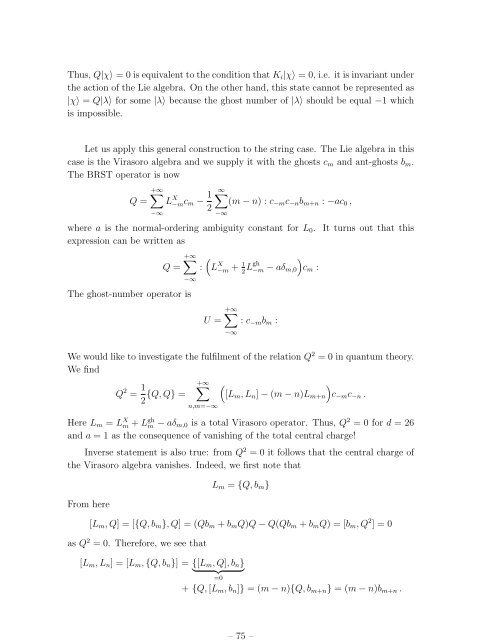Lectures on String Theory
Lectures on String Theory
Lectures on String Theory
Create successful ePaper yourself
Turn your PDF publications into a flip-book with our unique Google optimized e-Paper software.
– 75 –<br />
Thus, Q|χ〉 = 0 is equivalent to the c<strong>on</strong>diti<strong>on</strong> that K i |χ〉 = 0, i.e. it is invariant under<br />
the acti<strong>on</strong> of the Lie algebra. On the other hand, this state cannot be represented as<br />
|χ〉 = Q|λ〉 for some |λ〉 because the ghost number of |λ〉 should be equal −1 which<br />
is impossible.<br />
Let us apply this general c<strong>on</strong>structi<strong>on</strong> to the string case. The Lie algebra in this<br />
case is the Virasoro algebra and we supply it with the ghosts c m and ant-ghosts b m .<br />
The BRST operator is now<br />
Q =<br />
+∞∑<br />
−∞<br />
L X −mc m − 1 2<br />
∞∑<br />
(m − n) : c −m c −n b m+n : −ac 0 ,<br />
−∞<br />
where a is the normal-ordering ambiguity c<strong>on</strong>stant for L 0 . It turns out that this<br />
expressi<strong>on</strong> can be written as<br />
Q =<br />
+∞∑<br />
−∞<br />
:<br />
(<br />
L X −m + 1 2 Lgh −m − aδ m,0<br />
)c m :<br />
The ghost-number operator is<br />
U =<br />
+∞∑<br />
−∞<br />
: c −m b m :<br />
We would like to investigate the fulfilment of the relati<strong>on</strong> Q 2 = 0 in quantum theory.<br />
We find<br />
Q 2 = 1 +∞<br />
{Q, Q} =<br />
2<br />
∑<br />
n,m=−∞<br />
([L m , L n ] − (m − n)L m+n<br />
)<br />
c −m c −n .<br />
Here L m = L X m + L gh<br />
m − aδ m,0 is a total Virasoro operator. Thus, Q 2 = 0 for d = 26<br />
and a = 1 as the c<strong>on</strong>sequence of vanishing of the total central charge!<br />
Inverse statement is also true: from Q 2 = 0 it follows that the central charge of<br />
the Virasoro algebra vanishes. Indeed, we first note that<br />
From here<br />
L m = {Q, b m }<br />
[L m , Q] = [{Q, b m }, Q] = (Qb m + b m Q)Q − Q(Qb m + b m Q) = [b m , Q 2 ] = 0<br />
as Q 2 = 0. Therefore, we see that<br />
[L m , L n ] = [L m , {Q, b n }] = {[L m , Q], b n }<br />
} {{ }<br />
=0<br />
+ {Q, [L m , b n ]} = (m − n){Q, b m+n } = (m − n)b m+n .

















